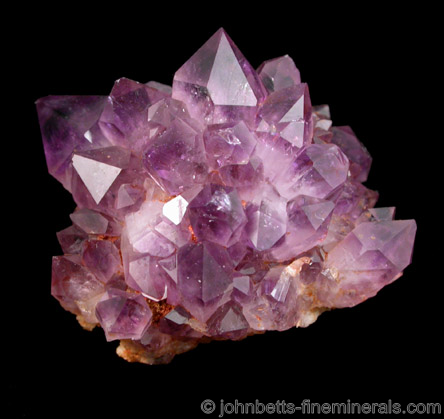The Mineral amethyst

Amethyst is a well known mineral and gemstone. It is the purple variety of the mineral Quartz, and its most valuable and prized variety.
Its name derives from the Greek "amethystos", which means "not drunken", as Amethyst in antiquity was thought to ward off drunkenness. The color of some Amethyst specimens from certain localities slowly fade upon prolonged exposure to light. When used as a gemstone, Amethyst is often heat treated to deepen the color, or to transform it into Citrine. Some varieties may also change to a light green color, which is given the trade name "Prasiolite", or "Green Amethyst", as it is more commonly known in the gem trade.
Amethyst is most prevalent as small stubby pyramidal crystals, although several localities such as the Mexican occurrences are well-known for producing elegantly tall prismatic crystals, which are very highly regarded by collectors. Amethyst also forms the internal lining of geodes, some of which can be over 10 feet tall and weighing several tons.
For additional information, see the gemstone section on Amethyst.
Color
Light to dark purple. Sometimes banded with purple and whitish lines. May also be mixed together with Citrine.
Crystal Habits
Most often as protruding clusters of pyramids on a matrix base. These "pyramids" can be quite large. Also occurs as tall prismatic crystals, as short stubby crystals, in drusy aggregates, massive, in geodes, and as rounded waterworn stones. A very interesting habit is as crystalline crusts inside volcanic pipes.
Crystals are usually striated horizontally, and occasionally have a scepter growth.
Varieties
-
Mixture of Amethyst and Citrine. It is partially purple and partially yellow or orange, with the color zones often sharply divided. More information can be found on the Ametrine gemstone page.
-
Form of Quartz, usually Amethyst, Citrine, or a combination of the two, that contains a large crystal or crystals overgrown with a layer of spiky smaller crystals. Cactus Quartz is specific to Boekenhouthoek (Magaliesberg) in South Africa.
-
Amethyst with an internal coating of red Hematite under the crystal surface, found near Thunder Bay, Ontario, Canada.
Uses
Amethyst is one of the most popular gems. It has a beautiful color and is fairly common, making it an inexpensive and widely used gem. Most Amethyst is faceted into jewelry cuts, and some are cut as cabochons. Large, massive chunks of Amethyst banded with Quartz is sometimes carved into ornaments.
Amethyst is also very popular among mineral collectors. Small geode sections and tumbled stones are sold to amateur collectors, while more serious collectors go for the rare prismatic crystals and giant geode sections.
Noteworthy Localities
Amethyst is a very common mineral and is found worldwide. Only a select few of the most famous localities will be mentioned here.
Tall, prismatic, well-shaped crystals are restricted to several Mexican localities: Piedras Parado and Las Vigas de Ramirez, both in Veracruz; and Amatitlan, in Guerro. They occur in elongated crystals that are rarely faceted, since collectors pay well for these rarities. Another excellent Mexican locality is Guanajuato, where plates of stubby crystals are found.
Enormous quantities of Amethyst come from Rio Grande do Sul, Brazil, where huge crystal-lined Amethyst geodes are found, especially at Ametista do Sul. Another South American country, Uruguay, produces deeply colored crystals in large geodes and pipes in Artigas, near the Brazilian border. An additional important South American locality, especially noted for Ametrine, is the Anahi Mine, Santa Cruz, Bolivia.
Large amounts of Amethyst are found both in Namibia and South Africa -- these are often labeled in the jewelry industry as "African Amethyst". In Namibia, an interesting occurrence is the Goboboseb Mountains, near Brandberg, in the Erongo Mountains, where crystals are zoned in lighter to darker colors. In South Africa, extensive deposits are in Boekenhouthoek (Magaliesberg), Mkobola district, where the Amethyst occurs with a spiky overgrowth of small crystals (popularly called "Cactus Quartz"). Very dark and clear Amethyst was once found in Russia in the Ural Mountains and
Siberia; and a drusy, lilac-colored Amethyst in globular
associations has recently come from Nyiri, in northeastern Hungary.
There are two notable Canadian occurrences. One is Thunder Bay, Ontario, where specimens contain an internal coating of red Hematite. The other locality is the area of Digby, Nova Scotia, where naturally rounded, waterworn Amethyst pebbles are found on the beaches along the Bay of Fundy.
In the U.S., fine Amethyst crystals comes from the Four Peaks (in the Mazatzal Mountains), Gila Co., Arizona; in the Pohndorf Mine, Jefferson Co., Montana; Crystal Park, Beaverhead Co., Montana; the Pennoyer Mine at Redfeather Lakes, Larimer Co., Colorado; and at Deer Hill, Oxford Co., Maine. There are several good localities in the Carolinas, specifically Statesville, Iredell Co., North Carolina; the Reel Mine, Iron Station, Lincoln Co., North Carolina; and Abbeville Co., South Carolina (the Diamond Hill Quartz Mine and the Ellis Jones Mine). A recently productive location producing deep purple crystals is Jackson's Crossroads, Wilkes Co., Georgia. Diamond Hill in Ashaway, Hopkinton, Washington Co., Rhode Island is known for the rare scepters that were found there. Amethyst is also found in the traprock quarries of Passaic Co., New Jersey, specifically at the Upper New Street Quarry in Paterson and at Prospect Park.
Common Mineral Associations
Other types of Quartz, especially Agate, Calcite, Hematite, Celadonite
Distingushing Similar Minerals
Fluorite - Much softer (4) and occurs in different crystal forms.
Apatite - Softer (5), rarely in pyramidal crystals.
Spinel - Occurs in different crystals, harder (7½ - 8).